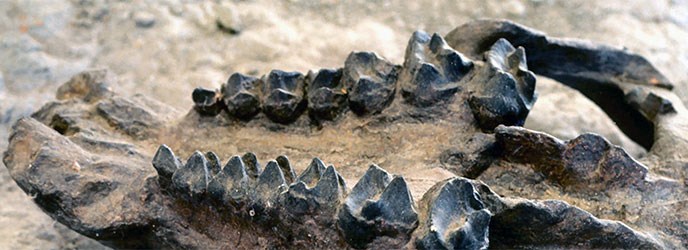
It is commonly accepted that the dinosaurs were driven to extinction by the drastic change in Earth’s climate brought about by the impact of a massive asteroid that occurred 66 million years ago. There is, however, evidence that the planet’s environment was already being upended by massive volcanic activity on the far side of the world, with toxic levels of mercury being spewed into a steadily warming atmosphere, before the sudden drop in temperatures caused by the Chicxulub impact killed three-quarters of all life on Earth.
About a quarter million years before the more famous Chicxulub impact, a series of long-term volcanic eruptions began in the western portion of what is now modern-day India. Possibly as a result of the breaking up of the Gondwana super-continent, these eruptions went on for approximately 33,000 years and covered an area of 1.5 million square kilometers (0.58 million square miles) in lava, inundating half of India. The legacy of these eruptions can be seen today, in a region called the Deccan Traps, a 500,000-square kilometer (200,000-square mile) region comprised of volcanic basalt.
Initially, the volcanic gases spewed into the atmosphere by the Deccan Traps eruptions, particularly sulphur dioxide (SO2) caused a 2°C (3.6°F) drop in temperatures over the 30,000 years leading up to the end of the Cretaceous period. But toward the end of the eruptive period, carbon dioxide emitted from the volcanoes initiated a brief period of global warming—along with an influx of toxic levels of mercury into the environment—as discovered by researchers from the University of Michigan in a recent study.
While investigating the geochemistry of fossilized seashells from the era, researchers detected evidence of a sudden surge of CO2 into the environment, an event that simultaneously caused a sharp acidification of the marine environment and drastic warming in the atmosphere above. This carbon influx would have placed a great deal of stress on the species that populated the planet at the time.
But that wasn’t the only environmental mess that the Deccan Traps’ eruptions caused: they also poured toxic levels of elemental mercury (Hg) into the environment. At the time, Hg levels had spiked to a point where they would be declared unsafe by modern environmental enforcement agencies.
Indeed, when compared to modern-day freshwater clam shells collected at a present-day site of industrial mercury pollution in Virginia’s Shenandoah Valley, the fossilized shells had comparable amounts of mercury in them. Well known for its toxic effects, a substantial influx of mercury into the environment could have placed a great deal of stress on the biology of species that existed at the time, and along with the changes brought about through the sudden spike in CO2 levels, the change in conditions might have driven some species to extinction long before the Chicxulub impact put its last nail in the coffin of the Cretaceous period.
“For the first time, we can provide insights into the distinct climatic and environmental impacts of Deccan Traps volcanism by analyzing a single material,” according to study lead author Kyle Meyer, now a postdoctoral researcher at Portland State University in Oregon. “It was incredibly surprising to see that the exact same samples where marine temperatures showed an abrupt warming signal also exhibited the highest mercury concentrations, and that these concentrations were of similar magnitude to a site of significant modern industrial mercury contamination.”
Subscribers, to watch the subscriber version of the video, first log in then click on Dreamland Subscriber-Only Video Podcast link.
1 Comment